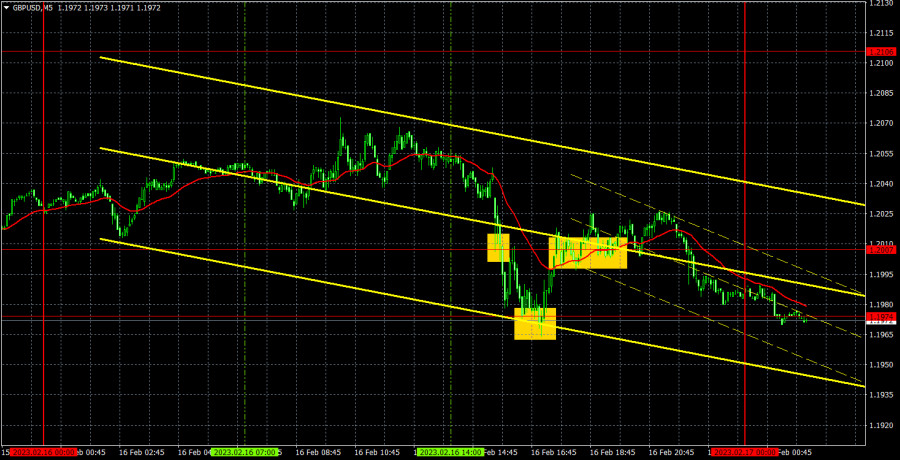

On Thursday, the GBP/USD currency pair resumed its downward trend following a slight upward pullback. The pound has no particular reason to keep falling because there were no significant reports in the UK today and practically all reports from the US were secondary and neutral. Yet, we are happy with this alternative because it perfectly matches our forecast. Because it has risen too quickly and significantly since its recent lows, we think the pound should continue to decline. We have been waiting for a corresponding correction after such a strong movement for more than a month. The market has been purchasing the pound by inertia for all this time, and it is now selling by inertia. The price is currently resting in the range of 1.1974–1.2007, which needs to be passed for it to continue heading south. The circumstances surrounding the euro and the pound are very comparable.
Yesterday, the pound generated three trade signals. Every aspect of 1.1974–1.2007 is the same. The distance between the tiers was around 30 points, respectively. As a result, as soon as a signal was generated, the price moved closer to another level. As a result, none of the created signals should have been processed, and no transactions should have been initiated during the day. Even the most recent signal (the consolidation over the region) formed too late to be tested. We anticipate a calm end to the week because there won't be any significant events this week, but we can't completely rule out the possibility that the pair will continue to move downward due to inertia.
The COT Report
The "bearish" sentiment appeared to be weakening in the most recent COT report on the British pound. The non-commercial group concluded 7,500 sell contracts and 6,700 buy contracts throughout the week. As a result, non-commercial traders' net position increased by 0.8 thousand. The net position indicator has been slowly rising over the past few months, and although it hasn't yet, it suggests that significant players' attitudes may soon turn "bullish." Although the value of the pound against the dollar has increased recently, it is quite challenging to identify the basic reasons behind this growth. While there is still a need for adjustment, we cannot rule out the possibility that the pound may continue to decline in the near (or medium) term. There are no questions because COT reports have generally matched the trend of the pound sterling in recent months. Purchases might go on for a while, as the net position isn't even bullish yet, but they need the right "foundation" to stand on, which they don't have now. A total of 35,000 contracts for purchases and 59,000 contracts for sales have now been opened by the non-commercial group. Although there are some reasons to believe that the British currency would increase over the long run, geopolitics does not support such a significant and quick pound sterling strengthening.
Analysis of GBP/USD 1H.

The pound/dollar pair started a new round of upward movement on the hourly timeframe and concluded it fairly quickly, as shown by the rising trend line, below which consolidation has already taken place. But, even below the 1.1974–1.2007 range, the price is unable to move in any way, so another upward rebound is now possible. In general, we think that the pound sterling will keep falling for a while. We highlight the following crucial levels on February 17: 1.1760, 1.1874, 1.1974-1.2007, 1.2106, 1.2185, 1.2288, 1.2342, 1.2429. Signal sources can also include the Kijun-sen (1.2116) and Senkou Span B (1.2180) lines. These levels and lines can be "bounced" and "surmounted" by signals. It is advised to set the stop loss level to breakeven when the price has moved 20 points in the desired direction. The Ichimoku indicator's lines might move during the day, therefore this should be considered while choosing trade signals. Support and resistance levels that can be used to determine transaction profit margins are also shown in the graphic. In the UK, a report on retail sales will be released on Friday, while there are no noteworthy events scheduled in the US. A small reaction might be provoked by a sales report, but only a small one.
Explanations for the illustrations:
Price levels of support and resistance (resistance/support) are thick red lines, near which the movement may end.
They don't provide trading signals, though.
The Ichimoku indicator's Kijun-sen and Senkou Span B lines have been moved from the 4-hour timeframe to the hourly one.
The price previously bounced off of the tiny red lines that represent extreme levels. They provide signals for trading.
Trend lines, trend channels, and other technical patterns are represented by yellow lines.
The net position size of each trading category is represented by indicator 1 on the COT charts.
The net position size for the "non-commercial" category is shown by indicator 2 on the COT charts.